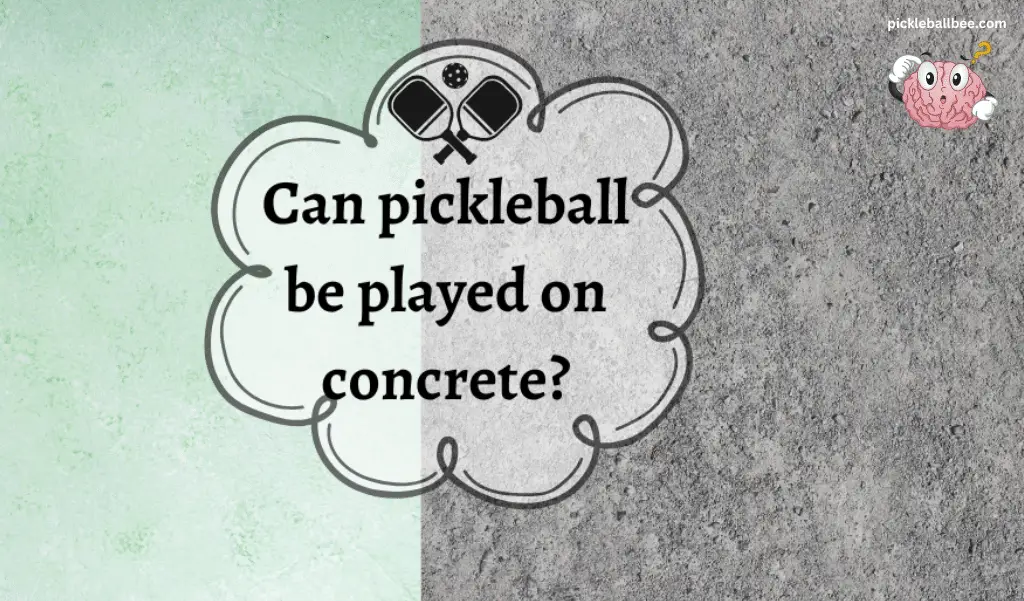
If you are an avid pickleball enthusiast, you know the importance of having a quality backboard to practice with. Not only does it allow for plenty of opportunities to hone your skills, but it can also help take your game to the next level. But How To Build A Pickleball Backboard? In this article, we will explore the various tools and materials needed to construct the perfect pickleball playing surface. This is so that you can enjoy all of its many benefits!
Table of Contents
Benefits of a pickleball backboard
Pickleball backboards offer several benefits for players of all skill levels. Here are some advantages.
Improves Skill Development: The most obvious benefit of having a pickleball backboard is that it allows you to practice and improve your skills. Hitting the ball off the backboard gives you more control over where it goes. This allows you to work on placement without worrying about opponent interference.
Enhances Shot Accuracy: By practicing with a backboard, players can improve their accuracy and shot placement. The backboard also makes it easier to practice different types of spin, as you can easily see what kind of spin the ball has when it comes off the board.
Increased confidence: With improved skill development and shot accuracy comes increased confidence in your game. Being able to hit accurate shots with control gives players an edge over their opponents.
Solo Practice: Pickleball is primarily a two-player game, but with a backboard, it can be played solo. This allows for more time to practice and hone your skills without coordinating schedules with another person.
Endless Fun: Lastly, having a pickleball backboard makes it possible to have fun while practicing! It’s an opportunity to get creative and explore creative strategies while improving your game.
Materials Needed
Now that we’ve looked at the benefits of a pickleball backboard, let’s move on to the materials needed to build one. Here are the items you will need:
- Wood: The most common material used for making pickleball backboards is wood. Plywood and MDF (medium-density fiberboard) are the two most popular choices, though you can also use hardwood such as maple or oak.
- Tools: You’ll need a variety of tools to construct your backboard, including saws, drills, sanders, and screwdrivers. You may also need a tape measure, clamps, and other accessories.
- Paint: If you plan on painting your backboard, make sure to purchase the appropriate type of paint for the material you’re using. For example, if you are working with wood, choose an exterior-grade paint that is designed to withstand outdoor elements such as rain and sun.
- Primer: For best results, it’s important to apply a primer before painting your backboard. This will help ensure that the paint adheres properly and doesn’t chip or fade quickly over time.
- Nails or Screws: Depending on the materials you are using, you may need either nails or screws to attach the pieces. Make sure you have the appropriate size and type for your project.
- Fasteners: If your backboard will be mounted to a wall or another surface, you’ll need special fasteners such as lag bolts or anchor bolts that are designed for outdoor use.
- Net: Finally, you’ll need a pickleball net to complete your backboard. The type of net you choose will depend on your budget and the size of your project.
How To Build A Pickleball Backboard?
Now that you have all the materials needed, let’s move on to step-by-step instructions for building a pickleball backboard.

Step 1: Measure and Cut Wood
Using a tape measure, measure and mark the dimensions of your backboard onto the wood. Then, use a saw or jigsaw to cut the pieces to size. It’s recommended to use ¾-inch plywood for most backboards, but you can also use thicker or thinner material depending on your preferences.
Step 2:Attach the Pieces
Once all of your wood pieces are cut, it’s time to attach them together. Use either nails or screws and secure the boards together. If you are using a thicker material, it’s recommended to use lag bolts and washers for extra stability.
Step 3:Sand Any Rough Spots
Smooth out any rough edges with sandpaper before moving on to the next step. This will ensure that your backboard looks professional when finished.
Step 4:Prime and Paint
Apply a primer to your backboard and allow it to dry before painting. Use exterior-grade paint designed for outdoor use, and apply multiple coats for best results. Allow the paint to dry completely before moving on to the next step.
Step 5:Attach Net
Once your backboard is complete, attach your pickleball net according to the manufacturer’s instructions. Make sure the net is securely fastened to the backboard, as this will ensure its longevity.
Step 6:Mount Backboard
It’s time to mount your finished pickleball backboard! If you plan on mounting your board to a wall or other surface, use appropriate outdoor fasteners designed for that purpose. Make sure that the backboard is secure and stable before playing.
Step 7:Install Accessories
Now that your backboard is completely assembled, you can install any additional accessories, such as net clips and corner guards, for added protection.
Step 8:Enjoy
You’re now ready to enjoy all pickleball backboard benefits! Whether you’re practicing alone or playing with friends, the possibilities are endless.
Crafting a pickleball backboard can seem intimidating at first, but with the right materials and tools, it is relatively straightforward. With some patience and diligent work, you can have a high-quality playing surface in no time. Good luck and happy pickleball!
ALSO READ: How Many Pickleball Courts Fit on a Basketball Court?
How To Use A Pickleball Rebounder Wall
When constructing a pickleball backboard, the key lies in the details.
Start by setting up the rebounder, closely adhering to the manufacturer’s instructions to ensure a sturdy frame and a net that is tightened and evenly spaced. Proper setup is crucial for the durability and effectiveness of the backboard. Next, position yourself adequately, facing the rebounder with enough space to move around and hit the ball comfortably. This setup not only aids in refining your shots but also enhances your overall game by allowing for smooth movement and consistent practice. As someone who has spent hours perfecting their pickleball skills, I can attest to the importance of a well-assembled backboard in improving both precision and power in your game.
To effectively use it, start by holding the pickleball paddle in your dominant hand. This familiarity in grip is essential for control and power. As you hit the ball towards the net, it’s crucial to pay attention to the angle, speed, and your shot’s consistency and accuracy, as these are the cornerstones of skill advancement in pickleball. The backboard allows you to repetitively practice these elements, fine-tuning your technique with each stroke. Remember, the key to improvement lies in deliberate and focused practice, where each hit becomes an opportunity to better your game.
The rebounder wall becomes an indispensable ally. It’s all about the rhythm – you hit the ball, it bounces back, and you’re ready to hit it again. This cycle is essential for sharpening your shot accuracy. As you continue this process, your footwork evolves, becoming more agile and precise. There’s a certain dance in the way you move, responding to the wall’s challenge. The wall doesn’t just return your shots; it’s a silent partner in your journey, pushing you to refine your technique and working with you toward excellence. It’s not just about the ball and the net; it’s about the dance, the rhythm, and the relentless pursuit of perfection.
When building a rebounder for pickleball, consider its role in practicing various pickleball drills. This tool is key for perfecting shots, especially groundstrokes, forehands, backhands, volleys, and even serves. The ability to adjust the angle and tension of the rebounder enhances its effectiveness. It’s not just about hitting a net; it’s about using it to simulate different strokes and situations in a game. The rebounder becomes an essential component in a player’s development, offering a range of practice scenarios.
To improve your game and hone specific skills in pickleball, the following steps involving the use of a rebounder wall are essential. Start by practicing regularly, which is key to making noticeable progress. The rebounder wall is a fantastic tool for this, allowing you to focus on various aspects of your play. Whether it’s working on your serves, volleys, or groundstrokes, this method ensures a comprehensive skill enhancement. Most importantly, remember to Have fun while practicing; enjoyment is crucial in maintaining motivation and enthusiasm for the game.
Tips and Tricks:
One of the finest ways to ensure a high-quality pickleball backboard is to use outdoor-grade materials. This will protect your backboard from environmental elements such as rain, snow, and the sun. If possible, try to install your backboard in an area shaded from direct sunlight or covered with a tarp when not in use.
If you are mounting your backboard to a wall, make sure the screws or bolts are drilled into studs for added stability and support. It’s also critical to properly seal any holes or cracks to prevent water damage over time.
Finally, it can be helpful to install corner guards on your backboard to protect the edges and prevent wear and tear. This is especially true if you plan on using your backboard in a highly competitive pickleball environment.
By following these tips and tricks, you can enjoy your pickleball backboard for many years to come. Happy building!
Safety Considerations:
Safety should always be a top priority when constructing any type of structure, and pickleball backboards are no exception. Here are some important safety considerations to keep in mind:
- Wear protective gear such as goggles and gloves while using power tools.
- Make sure you have adequate ventilation when working with paints or other potentially hazardous materials.
- Always read and adhere to the safety instructions of any tools or materials you use.
- Avoid working alone when using power tools; always have a partner present in case of an emergency.
- Take frequent breaks while working on your backboard, especially if it’s a large project.
By following these safety considerations, you can help ensure that your pickleball backboard-building experience remains safe and enjoyable. Have fun and stay safe!
Pros/Cons Of A DIY Pickleball Rebounder
| Pros | Cons |
| Building your own DIY pickleball rebounder offers unmatched customization in size, shape, and features, tailored to your needs, enhancing your training experience on a court that truly mimics a real game’s dynamics. | While building a DIY pickleball rebounder, you’ll invest considerable time and effort to gather materials and tools, and assemble the setup, requiring basic skills and following precise instructions. |
| Opting for a DIY approach can be significantly more cost-effective than buying a pre-made model, with the added advantage of being able to modify and upgrade as your skills improve or needs change. | The process demands careful and precise work; otherwise, the finished rebounder may lack the sturdiness and quality of well-made, pre-made models, potentially affecting its longevity and performance. |
| By selecting specific materials, adjusting net tension, and setting the rebound angle, you create a rebounder that not only mimics the bounce of a real court but also supports upgraded functionality as you evolve. | Despite your best efforts, achieving a consistent bounce akin to professional models can be challenging, as DIY solutions might not always replicate the exact bounce and rebound dynamics of high-end, professional equipment. |
ALSO READ: Can You Serve Overhand In Pickleball?
Conclusion
Building a pickleball backboard can be rewarding and enjoyable. With the right materials, tools, and instructions, you can create a high-quality playing surface in no time. Always remember to consider safety and follow all instructions carefully when constructing your backboard. With patience and dedicated work, you can enjoy your new pickleball backboard for years to come. Have fun and happy building!
FAQs:

-
What is the most suitable material for a pickleball backboard?
The most suitable material for a pickleball backboard depends on your budget and desired outcome. Plywood is generally the most cost-effective option, but you could also use fiberglass or acrylic if you want a more durable surface.
-
What type of fasteners do I need for mounting my backboard?
If you plan on mounting your backboard to a wall or other surface, you’ll need special fasteners such as lag bolts or anchor bolts designed for outdoor use. Be sure to double-check the fasteners’ weight capacity before installation.
-
Can I add additional accessories to my pickleball backboard?
Yes, there are several additional accessories you can add to your backboards, such as corner guards or net clips. These will protect the edges of your backboard and provide extra stability for your pickleball net.
-
Is it difficult to build a pickleball backboard?
No, crafting a pickleball backboard doesn’t have to be difficult. As long as you have the right materials, tools, and instructions, it can be a relatively straightforward process. With some patience and diligent work, you’ll have a high-quality playing surface in no time.
-
How much does it cost to build a pickleball backboard?
The cost of building a pickleball backboard can vary depending on the size and materials used. Generally speaking, you can expect to spend anywhere from $50-$100 for basic materials such as plywood or fiberglass panels, netting, and fasteners. If you plan on using higher-end materials such as acrylic, the cost could be significantly more.


